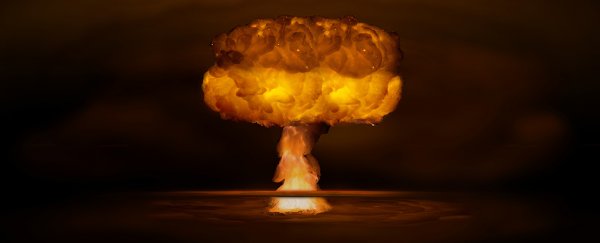It's clear that a nuclear war would be catastrophic for us and our planet – but just how catastrophic? A new study models the impact that smoke from the fall-out of a nuclear conflict would have on our atmosphere – and the results are predictably bleak.
The models used here are some of the most up-to-date and detailed ever put to the task, and it factors in the complex chemical reactions that would happen in the stratosphere, one of the lower levels of Earth's atmosphere.
What the new findings point to is that damage to the environment could be more severe and last longer than previous studies have found, factoring in damage from the initial heating effect of nuclear explosions as well as the subsequent ozone layer loss.
"Although we suspected that ozone would be destroyed after nuclear war and that would result in enhanced ultraviolet light at the Earth's surface, if there was too much smoke, it would block out the ultraviolet light," says climate scientist Alan Robock, from Rutgers University in New Jersey.
"Now, for the first time, we have calculated how this would work and quantified how it would depend on the amount of smoke."
The team analyzed the impact of both a regional and global nuclear war, with 5 megatons and 150 megatons of soot released respectively. A global war would leave an average ozone layer loss of 75 percent over the course of 15 years, the researchers found, with a regional war resulting in a 25 percent ozone layer loss over a period of 12 years.
According to the study, although the smoke would block the Sun's rays initially, stronger bursts of ultraviolet light would follow within a few years – allowed to hit the surface of Earth through damage to the ozone layer.
Both the initial blast, through chemical reactions with nitrogen oxides, and the smoke itself via heating and reduction of photochemistry which interfere with natural atmospheric interactions, would contribute to the loss of ozone.
With variations in UV light linked to everything from skin cancer to agriculture processes to the survival of entire ecosystems, having much more of it arriving on our planet would have profound consequences for anyone and anything that survived the initial blasts. A global war would be worse, but a regional war would still be devastating.
"Conditions would switch dramatically, and adaptations that may work at first won't help as temperatures warm back up and UV radiation increases," says atmospheric scientist Charles Bardeen, from the National Center for Atmospheric Research (NCAR) in Colorado.
"Just as the smoke is clearing up, you would get this blast of UV with completely different impacts on human health and agriculture."
The earliest nuclear war models from the 1980s predicted a nuclear winter, with smoke from the blasts and subsequent fires blocking out the Sun and its warmth. Later models have since considered how rising temperatures as well as direct damage might impact the ozone layer through the heating of the stratosphere.
It's important to bear in mind that nuclear arsenals continue to change as well: countries like India and Pakistan have most likely gained more weapons and more powerful weapons, while for the US and Russia, the trend is reversed.
This study aims to incorporate as many of these different considerations as possible to show the potential differences between global and regional nuclear war – with the end result being that there's no escape from the effects over subsequent decades, no matter where you are on Earth.
"In addition to all the fatalities that would happen almost immediately, the climate effects and the UV effects would be widespread," says Bardeen.
"These aren't local to where the war occurs. They're global, so they would affect all of us."
The research has been published in Journal of Geophysical Research: Atmospheres.
